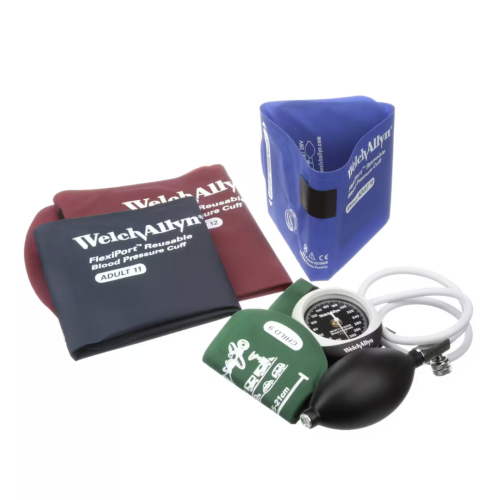
Blood pressure monitoring is an essential component of patient care in all healthcare environments. Whether you're assessing patients in a busy outpatient clinic, training the next generation of medical professionals, or providing care in the field, having the right blood pressure monitor is crucial. With numerous options on the market, the decision often comes down to choosing between manual and digital blood pressure monitors. Both have distinct advantages and considerations, so selecting the right one depends on your unique needs.
This guide explores the differences between manual and digital blood pressure monitors to help you choose the best tool for your practice.
Manual Blood Pressure Monitors – Trusted Accuracy in Trained Hands
How They Work
Manual blood pressure monitors (also known as sphygmomanometer) rely on three key components:
- Stethoscope to listen to arterial sounds.
- Inflation bulb and cuff to restrict blood flow temporarily.
- Aneroid gauge to measure systolic and diastolic pressure as detected by sounds.
This traditional method is highly precise when performed correctly, making it the gold standard in many scenarios.
Advantages of Manual Blood Pressure Monitors
- No Batteries or Electronics: Manuals are completely mechanical, so you don’t have to worry about battery life or malfunctioning electronic components.
- High Accuracy: Dependable when used by trained professionals, especially valuable in scenarios where arrhythmias might interfere with automated readings.
- Durability: Lack of electronic components ensures long-lasting performance and reliability.
- Cost-Effective: Generally less expensive than digital counterparts, reducing overhead costs for healthcare facilities.
Ideal For
- Physicians performing detailed diagnostics.
- EMTs and Field Medics operating in unpredictable environments.
- Training with Medical Students to master auscultation techniques and fully understand the process.
Limitations
- Skill Dependent: Accurate readings require training and experience, making it less ideal for untrained users or patients who need to self-monitor.
- Time-Consuming: Measuring blood pressure with a manual device requires more time and effort, potentially slowing workflow in high-volume settings.
Recommended Manual Blood Pressure Monitors
- ADC Prosphyg™ 760 Pocket Aneroid Sphyg: Compact, robust, and affordable, this aneroid cuff is a staple for physicians.
- Welch Allyn DS45 Durashock: Featuring a shock-resistant design with an integrated gauge and cuff, this monitor is built for reliability and efficiency.
Digital Blood Pressure Monitors – Speed and Simplicity for High-Volume Environments
How They Work
Digital blood pressure monitors utilize the oscillometric method, which electronically senses the vibrations of blood flowing through the arteries. These devices automate inflation, deflation, and measurement, allowing for effortless blood pressure monitoring.
Advantages of Digital Blood Pressure Monitors
- Ease of Use: Requires no specialized training, making it an excellent choice for all users, including patients and caregivers.
- Time-Saving: Digital monitors are faster, making them ideal for high-volume environments such as outpatient clinics or inpatient wards.
- Minimizes User Error: Automation reduces variability, especially in noisy or chaotic environments.
- Self-Monitoring: Allows patients and home healthcare providers to easily track and manage blood pressure over time.
Ideal For
- Outpatient and Ambulatory Clinics needing to manage large patient volumes quickly.
- Home Healthcare Providers supporting patients who need easy-to-use, self-monitoring tools.
- Nurses managing multiple patients with minimal delays.
Limitations
- Dependence on Batteries or Power Sources: Digital monitors need charging or replacement batteries, requiring ongoing maintenance to ensure operation.
- Higher Cost: Digital models often carry a premium price tag compared to manual sphygmomanometer.
- Sensitivity to Some Conditions: Certain clinical situations, like irregular heart rhythms, may lead to less accurate readings.
Recommended Digital Blood Pressure Monitors
- Welch Allyn ProBP 2400: A highly accurate monitor with automatic inflation and dual cuff sizes for versatile use in clinics.
Which One Is Right for You?
Every medical environment has unique requirements, and the choice between manual and digital blood pressure monitors often depends on your setting, patient population, and personal preferences. Here’s a quick guide to help you decide:
|
Use Case |
Recommended Type |
Why |
|---|---|---|
|
ER/ICU |
Manual |
Delivers reliable readings with hands-on control, especially for arrhythmias. |
|
General Practice |
Digital or Hybrid |
Ensures fast workflows while maintaining accuracy for moderate patient volumes. |
|
Home Healthcare |
Digital |
Simplifies self-monitoring for patients and caregivers. |
|
Medical Students |
Manual |
Essential for learning the correct auscultation technique. |
|
Mobile Clinics |
Manual or Multi-Cuff Kit |
Lightweight, portable, and reliable for varying conditions. |
Our Picks at SurgoMed
We’ve curated a selection of blood pressure monitors that deliver unmatched value for various healthcare environments:
- ADC Basic Aneroid Sphygmomanometer (Large Cuff): A budget-friendly manual monitor offering dependable accuracy and durability.
- Welch Allyn Gold Series DS66 with FlexiPort Multi-Cuff Kit: Premium design for hospitals and clinics requiring a versatile, multi-patient solution.
- Welch Allyn ProBP 2400: A high-performance digital model offering automated inflation and an included dual-cuff system.
- Welch Allyn DS45 Durashock: Compact, shock-resistant, and designed for long-term use in demanding settings.
Explore these options on our website to find the perfect fit for your practice.
Choosing the Best Blood Pressure Monitor for Your Practice
Both manual and digital blood pressure monitors have a vital role to play in modern healthcare. Manual tools remain the gold standard for accuracy in trained hands, while digital models excel in speed, ease of use, and versatility.
At SurgoMed, we offer trusted solutions tailored to your specific needs, whether you're equipping a hospital emergency department, supporting patients at home, or teaching budding medical professionals.
Equip your practice today, browse our range of Welch Allyn and ADC blood pressure monitors and choose tools that work as hard as you do.










